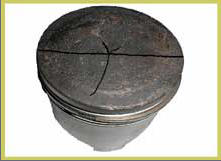

























Piston engine problem Brisbane - CRACKED
Pistons in diesel, petrol and LPG engines work under very tough conditions. Almost all modern pistons are manufactured using an aluminium based alloy. This is a very light and durable material which is ideal for piston manufacture. Different methods of production are used such as cast or dropped forged. Drop forged pistons are less prone to cracking but due to the extra cost involved in production cast alloy pistons are the most commonly used in standard production engines. Almost all performance engine builders use forged pistons. Diesel engines in haulage trucks are more prone to cracking across the crown. “Cracking of the piston crown” is normally caused by thermal fatigue. This condition exist due to the severe temperatures and loads applied to the piston from combustion as the truck engine with heavy loads negotiates a steep hill followed by an easy run down the other side. These two opposite load situations constantly cycle the piston through very high temperatures and down to rather moderate temperatures. Over a period of time these constant thermal cycles weaken the piston crown material and cracks start to appear. This is very evident in direct injection diesel pistons where the combustion chamber is built into the piston crown and the cylinder head is basically flat. Some petrol engines suffer from broken or “cracked piston skirts”. As these pistons are made as light as possible to enhance performance some manufacturers get the design a little wrong leading to cracked piston skirts early in the engines life. This was evident in the 1990's where some Pistons part numbers were recalled and superseded with another stronger design. Due to improvements in design most modern pistons do not suffer from cracked piston skirts. Under normal operating conditions piston ring lands come under severe load simply because they are directly in-line with combustion pressure and temperature. Any abnormal increase in these conditions can cause the piston ring land to crack. Petrol engines running lean or over advanced will promote “piston ring land cracking”. This condition is terminal as the piston ring can not hold compression once the ring land cracks. Disclaimer Agreement : Every care has been taken in writing this information and procedures, but no responsibility can be excepted for errors, omissions or misuse of this information and procedures. The information available on this site is for your instruction only and cannot be copied for sale, © copyright 2001 UMR Engines



Piston cracked on skirt
Cracked crown of piston
Cracked Ring Lands





















•
Queensland Transport Authorised to approve LA1,LA3,LB1,LD1-2,LK1,LK6 Modification’s to light vehicles
•
LPG Approved Workshop
•
RWC Licence
•
RACQ Approved Automotive Repairer





Piston engine problem Brisbane -
CRACKED
Pistons in diesel, petrol and LPG engines work under very tough conditions. Almost all modern pistons are manufactured using an aluminium based alloy. This is a very light and durable material which is ideal for piston manufacture. Different methods of production are used such as cast or dropped forged. Drop forged pistons are less prone to cracking but due to the extra cost involved in production cast alloy pistons are the most commonly used in standard production engines. Almost all performance engine builders use forged pistons. Diesel engines in haulage trucks are more prone to cracking across the crown. “Cracking of the piston crown” is normally caused by thermal fatigue. This condition exist due to the severe temperatures and loads applied to the piston from combustion as the truck engine with heavy loads negotiates a steep hill followed by an easy run down the other side. These two opposite load situations constantly cycle the piston through very high temperatures and down to rather moderate temperatures. Over a period of time these constant thermal cycles weaken the piston crown material and cracks start to appear. This is very evident in direct injection diesel pistons where the combustion chamber is built into the piston crown and the cylinder head is basically flat. Some petrol engines suffer from broken or “cracked piston skirts”. As these pistons are made as light as possible to enhance performance some manufacturers get the design a little wrong leading to cracked piston skirts early in the engines life. This was evident in the 1990's where some Pistons part numbers were recalled and superseded with another stronger design. Due to improvements in design most modern pistons do not suffer from cracked piston skirts. Under normal operating conditions piston ring lands come under severe load simply because they are directly in-line with combustion pressure and temperature. Any abnormal increase in these conditions can cause the piston ring land to crack. Petrol engines running lean or over advanced will promote “piston ring land cracking”. This condition is terminal as the piston ring can not hold compression once the ring land cracks. Disclaimer Agreement : Every care has been taken in writing this information and procedures, but no responsibility can be excepted for errors, omissions or misuse of this information and procedures. The information available on this site is for your instruction only and cannot be copied for sale, © copyright 2001 UMR Engines


Piston cracked on skirt
Cracked Ring Lands




7 Moss Street, Slacks Creek, Qld 4127






































